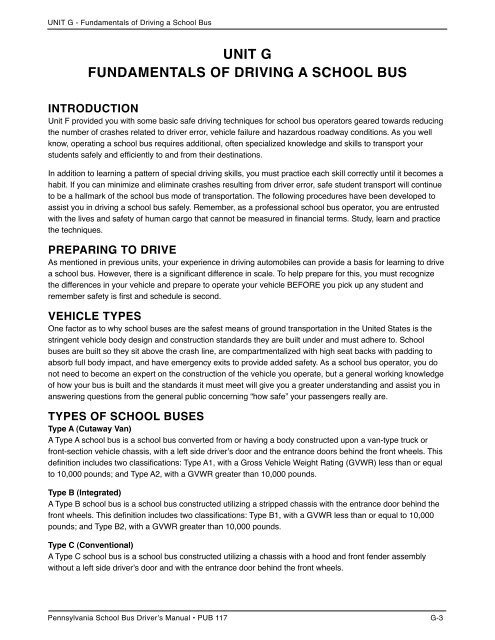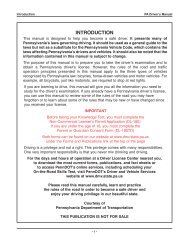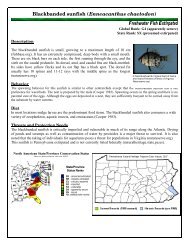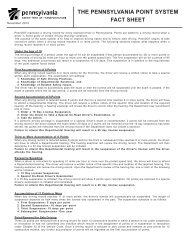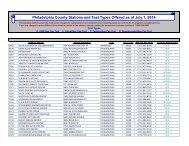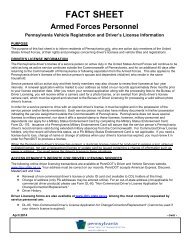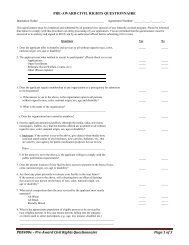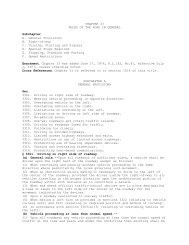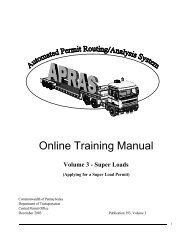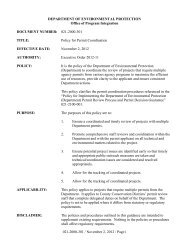fundamentals of driving a school bus - PennDOT Driver and Vehicle ...
fundamentals of driving a school bus - PennDOT Driver and Vehicle ...
fundamentals of driving a school bus - PennDOT Driver and Vehicle ...
- No tags were found...
Create successful ePaper yourself
Turn your PDF publications into a flip-book with our unique Google optimized e-Paper software.
UNIT G - Fundamentals <strong>of</strong> Driving a School BusUNIT GFUNDAMENTALS OF DRIVING A SCHOOL BUSINTRODUCTIONUnit F provided you with some basic safe <strong>driving</strong> techniques for <strong>school</strong> <strong>bus</strong> operators geared towards reducingthe number <strong>of</strong> crashes related to driver error, vehicle failure <strong>and</strong> hazardous roadway conditions. As you wellknow, operating a <strong>school</strong> <strong>bus</strong> requires additional, <strong>of</strong>ten specialized knowledge <strong>and</strong> skills to transport yourstudents safely <strong>and</strong> efficiently to <strong>and</strong> from their destinations.In addition to learning a pattern <strong>of</strong> special <strong>driving</strong> skills, you must practice each skill correctly until it becomes ahabit. If you can minimize <strong>and</strong> eliminate crashes resulting from driver error, safe student transport will continueto be a hallmark <strong>of</strong> the <strong>school</strong> <strong>bus</strong> mode <strong>of</strong> transportation. The following procedures have been developed toassist you in <strong>driving</strong> a <strong>school</strong> <strong>bus</strong> safely. Remember, as a pr<strong>of</strong>essional <strong>school</strong> <strong>bus</strong> operator, you are entrustedwith the lives <strong>and</strong> safety <strong>of</strong> human cargo that cannot be measured in financial terms. Study, learn <strong>and</strong> practicethe techniques.PREPARING TO DRIVEAs mentioned in previous units, your experience in <strong>driving</strong> automobiles can provide a basis for learning to drivea <strong>school</strong> <strong>bus</strong>. However, there is a significant difference in scale. To help prepare for this, you must recognizethe differences in your vehicle <strong>and</strong> prepare to operate your vehicle BEFORE you pick up any student <strong>and</strong>remember safety is first <strong>and</strong> schedule is second.VEHICLE TYPESOne factor as to why <strong>school</strong> <strong>bus</strong>es are the safest means <strong>of</strong> ground transportation in the United States is thestringent vehicle body design <strong>and</strong> construction st<strong>and</strong>ards they are built under <strong>and</strong> must adhere to. School<strong>bus</strong>es are built so they sit above the crash line, are compartmentalized with high seat backs with padding toabsorb full body impact, <strong>and</strong> have emergency exits to provide added safety. As a <strong>school</strong> <strong>bus</strong> operator, you donot need to become an expert on the construction <strong>of</strong> the vehicle you operate, but a general working knowledge<strong>of</strong> how your <strong>bus</strong> is built <strong>and</strong> the st<strong>and</strong>ards it must meet will give you a greater underst<strong>and</strong>ing <strong>and</strong> assist you inanswering questions from the general public concerning “how safe” your passengers really are.TYPES OF SCHOOL BUSESType A (Cutaway Van)A Type A <strong>school</strong> <strong>bus</strong> is a <strong>school</strong> <strong>bus</strong> converted from or having a body constructed upon a van-type truck orfront-section vehicle chassis, with a left side driver’s door <strong>and</strong> the entrance doors behind the front wheels. Thisdefinition includes two classifications: Type A1, with a Gross <strong>Vehicle</strong> Weight Rating (GVWR) less than or equalto 10,000 pounds; <strong>and</strong> Type A2, with a GVWR greater than 10,000 pounds.Type B (Integrated)A Type B <strong>school</strong> <strong>bus</strong> is a <strong>school</strong> <strong>bus</strong> constructed utilizing a stripped chassis with the entrance door behind thefront wheels. This definition includes two classifications: Type B1, with a GVWR less than or equal to 10,000pounds; <strong>and</strong> Type B2, with a GVWR greater than 10,000 pounds.Type C (Conventional)A Type C <strong>school</strong> <strong>bus</strong> is a <strong>school</strong> <strong>bus</strong> constructed utilizing a chassis with a hood <strong>and</strong> front fender assemblywithout a left side driver’s door <strong>and</strong> with the entrance door behind the front wheels.Pennsylvania School Bus <strong>Driver</strong>’s Manual • PUB 117 G-3


